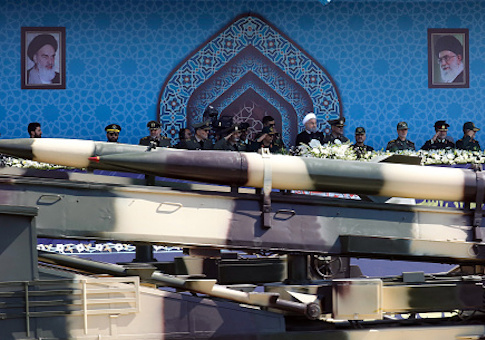Iran unveiled a series of new homemade nuclear-capable ballistic missiles during military parades held over the weekend, a move that experts view as a bid to bolster the hardline ruling regime as dissidents continue efforts to stir protest.
On the heels of an encounter between an Iranian drone and Israeli forces, Iranian leaders showcased their ballistic missile capabilities, which includes a nuclear-capable medium-range missile that appears to share similarities with North Korean technology, according to experts.
The nuclear-capable missile can strike Israel even when fired from Iranian territory, raising concerns about an impending conflict between Tehran and the Jewish state that could further inflame the region.
Iranian military leaders bragged the ballistic missile "can be launched from mobile platforms or silos in different positions and can escape missile defense shields due to their radar-evading capability," according to reports in Iran's state-controlled media.
The latest technology could further inflame tensions between Israel and Iran, which funds and controls terror organizations operating along Israel's border. Concerns that this nuclear-capable technology could be shared by Iran with its terrorist proxies are fueling longstanding concerns among the Israelis that an attack is imminent.
As Iranian dissidents continue to protest over the country's ailing economy, the ruling regime continues to invest millions of dollars it received as part of the landmark nuclear deal with the United States on its military technology, specifically ballistic missiles, which are subject to a ban under international statutes.
However, Iran has not only continued this work but also invested heavily in it since receiving the cash windfalls from the nuclear deal. Conservative estimates from open sources indicate the Iranian regime has spent at least $16 billion in recent years on its military buildup and rogue operations in Syria, as well as other countries.
"Thirty-nine years in, the Islamic Revolution has little to show for its decades in power other than growing the country's asymmetric military capabilities in order to continue their export of the revolution," Behnam Ben Taleblu, an Iran expert with the Foundation for Defense of Democracies, told the Washington Free Beacon. "The Islamic Republic has considerably grown the country's missile and rocket arsenal, both through production and procurement."
The two missiles featured over the weekend by Iran include the Ghadr, a medium-range ballistic missile that was modified and upgraded by the Islamic Republic
"The Ghadr can strike Israel when fired from Iranian territory, and in March 2016, was flight-tested while bearing genocidal slogans against the state of Israel," according to Ben Taleblu, who has researched Iranian missile procurement.
Iranian military leaders also rolled out a rocket called the Fajr-5, which is becoming a new favorite of Iranian-backed terror proxy groups operating against Israel.
"The Fajr-5 is an Iranian rocket that has been proliferated to anti-Israel groups like Hamas and Hezbollah. It can travel up to 75 km, and is therefore a long-range artillery rocket. It uses solid fuel for propulsion," Ben Taleblu explained. "Both the Qadr missile and Fajr rocket represents Iran's commitment to developing stand-off weaponry that it uses for purposes of deterrence and coercion."
The new weaponry could fuel ongoing efforts by Congress to crackdown on Iran's continued proliferation of ballistic missile technology, a large part of which has been incubated by the North Korean regime, which continues to have a technology-sharing agreement with Tehran.
Iran already has the region's largest arsenal of ballistic missiles and is seeking to continue building this technology.
The Trump administration has said that any effort to fix the nuclear deal with Iran must focus on constricting the regime's access to ballistic missile technology.
